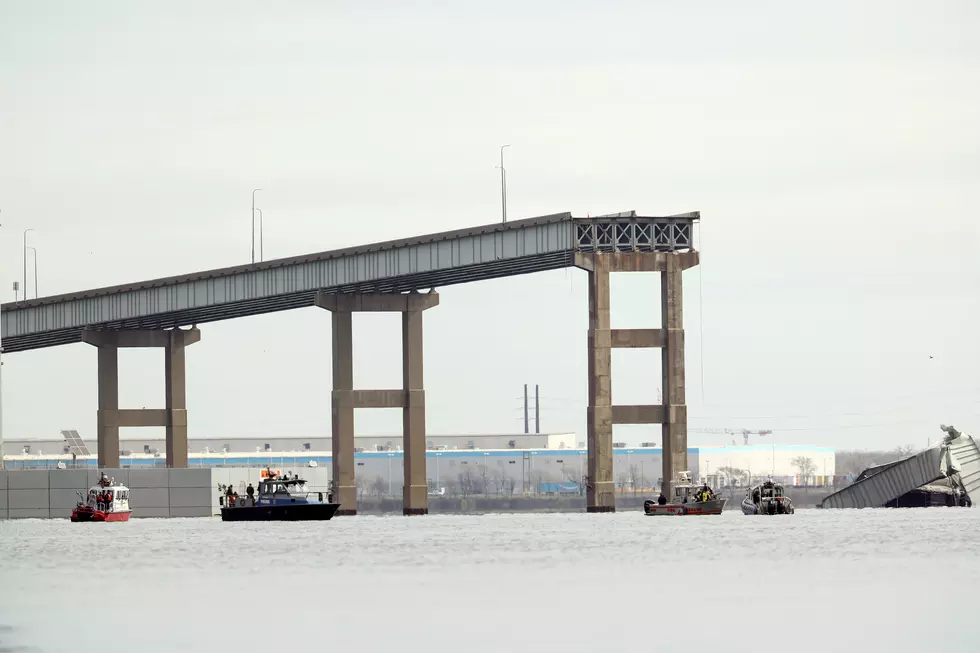
What Would Happen if One of Michigan’s Critical Bridges Collapsed?
Early Tuesday Morning, something almost unthinkable happened in Baltimore, Maryland that shook the country. A container ship collided with the Francis Scott Key Bridge, and caused it to plummet 180 feet into the Patapsco River. Details are still coming out as to what led to this, and who all is directly affected, but some reports now say at least six people are still missing and presumed dead.
But after a day of reflection, it isn't unthinkable now, that something similar could happen to bridges all over the country in major areas of commerce travel. Michigan, in fact, has four major bridge crossings that span across the Great Lakes. So if something like what happened in Baltimore happened to any of these bridges, what could, or would the state be able to do?

For context, there are three publicly-owned bridges that cross the Great Lakes in Michigan - The International Bridge, the Blue Water Bridge, and the Mackinac Bridge. Only the Mackinac Bridge stays wholly in the United States, as the International Bridge and Blue water Bridges both cross into Ontario at Sault Ste. Marie and Port Huron, respectively.
There is one other, the Ambassador Bridge in Detroit, that is privately owned, and connects the city to Windsor, Ontario.
Aside from the Detroit-Windsor Tunnel, these are the only four major crossings over the Great Lakes, that has nearly 3,000 miles of coastline with Michigan. Four Crossings, in 3,000 miles is incredible.
So what would happen if something like the Francis Scott Key Bridge happened here?
First of all, it would take a severely heavy hit to knock out some of these bridges. The Mackinac alone is MASSIVELY tall, and long, built to withstand a lot of force and energy. But if you're a cargo ship hauling hundreds of thousands of tons of ore, or goods through the Straits, it's possible the infrastructure of the bridge could be heavily damaged.
Mackinac Bridge
For the Mackinac Bridge, there would be no way, aside from a ferry, to cross the straits with a vehicle anymore. And even then, the state-run ferry system for vehicles was discontinued after the bridge was built. The only ferries that run in the straits now are to and from Mackinac Island... and those don't allow cars.
The Upper Peninsula would almost certainly be cut off from the rest of Michigan for a time, before something could be put into place, AND, if all shipping traffic were halted, then Lake Michigan would be completely cut off from the rest of the Great Lakes system.
International Bridge
If something happened to the International Bridge at Sault Ste. Marie, Lake Superior would almost certainly be cut off from the rest of the Great Lakes. The Bridge spans across the St. Mary's River BEFORE the fork, leaving commercial shipping stuck on either side, and no way for the Upper Peninsula to connect to Canada.
It's saving grace, however, is that there are several sections to the International Bridge that span across multiple locks for ships to move through. No matter what, if one section were impacted, road traffic would come to a halt, but it's possible shipping lanes could still stay open, at least on one side, and probably very congested.
Also, most of the supports for the critical points of the bridge are still on land, so the likelihood of this happening is slim... but still not impossible.
Blue Water Bridge
The Blue Water Bridge, right at the mouth of the St. Clair River where it meets Lake Huron, would also be a really bad spot for this to happen. An INSANE amount of commercial traffic crosses that bridge in and out of Canada and the state of Michigan.
Aside from the Ambassador Bridge in Detroit, it's the only crossing into Canada between the Upper Peninsula, and Buffalo, New York. However, it is the only PUBLIC bridge crossing between those two places.
Thankfully, this is another example of a long-spanning bridge over water where the supports are cemented on land, rather than in the water, so again, a slim possibility this could happen, but not impossible.
The Ambassador Bridge
And finally, the Ambassador Bridge in Detroit, spanning, again, across the St. Clair River, below Lake St. Clair. one of the busiest crossings into and out of Canada for the country, this would be detrimental for both commercial shipping and traffic on land, and through the Lakes.
The supports for this bridge are WELL out of the way of shipping lanes on the river, but as we've seen, accidents can happen
Effectively, if any of these bridges failed, and fell, blocking shipping traffic on the water, almost all shipping through the Great Lakes would either be halted, or severely handicapped and relocated to which lakes they had access to. Not to mention, anything to the west of any of these bridges would effectively be stuck until a shipping lane could open.
Now, of course, this is worse case scenario, and something like what happened in Baltimore is VERY very rare. But, it does make you think about how frail our access to the other side of the water really is in the State of Michigan. Soon enough, though, we'll have another crossing in Detroit with the Gordie Howe International Bridge, expected to open September of 2025.
The Best Photo of the Mackinac Bridge You've Never Seen
Gallery Credit: Facebook
Check Out The Straights of Mackinac...From 40,000 Feet In The Air
Gallery Credit: Bryan Buzz- buzzinaroundtheworld.com




